ikfoundation.org
The IK Foundation
Promoting Natural & Cultural History
Since 1988


APPLIQUÉ AND SILK BROCADES
– Medieval Textiles
The complex appliqué technique was a usual addition for the professional embroiderers in European workshops, when decorating/illustrating the silk vestments with biblical motifs etc. This third historical essay about the Medieval textile collection in St Petri church – aims to present a few very detailed images of these exquisite fabrics together with a glimpse of such silk brocades and how these qualities could be added with fringes, ribbons and other attributes. The beautiful and unique fragments will also be compared with fully preserved items from two other nearby collections. This comparison shows that similar liturgical textiles were in use more than thousands of kilometres apart, due to that imported Medieval fabrics and embroideries were in frequent use in the Nordic area. In contrast, other textiles stayed in their country of origin (Italy or Spain) and first ended up in Malmö when purchased by the museum in the 20th century.
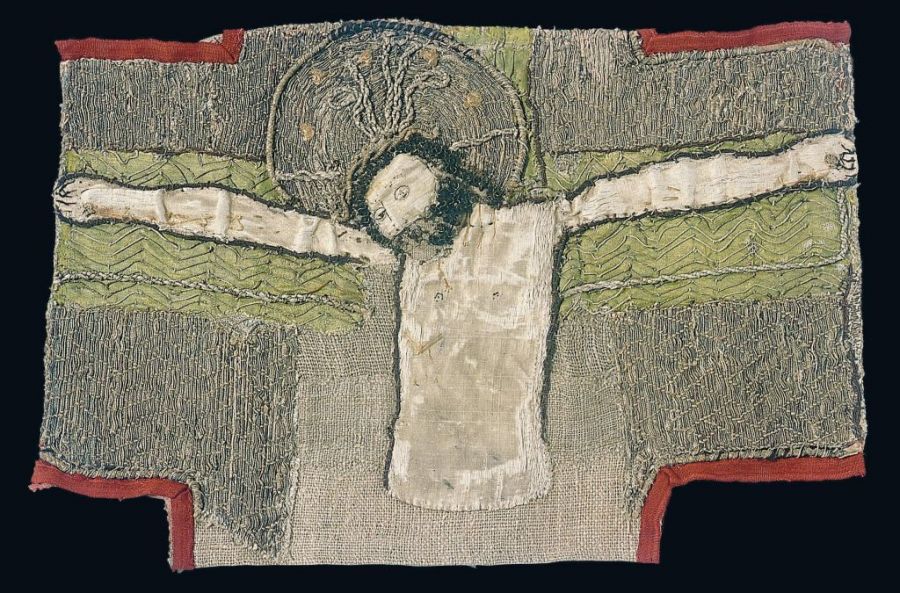 This fragmented piece of “The Crucifixion” – once the centre point of the cross on a chasuble, demonstrates various embroidery techniques. Jesus was made in an appliqué style of white silk fabric neatly nested to a foundation of linen. Various stitching gives life to his face and hair, while the background in an intricate laid work of gold and silk probably indicates that this embroidery originated from a professional workshop in Flanders. Red and green silk fabrics are also significant decorative parts of the composition; height 26,5 cm and width 38,5 cm. Photo: The IK Foundation, London.
This fragmented piece of “The Crucifixion” – once the centre point of the cross on a chasuble, demonstrates various embroidery techniques. Jesus was made in an appliqué style of white silk fabric neatly nested to a foundation of linen. Various stitching gives life to his face and hair, while the background in an intricate laid work of gold and silk probably indicates that this embroidery originated from a professional workshop in Flanders. Red and green silk fabrics are also significant decorative parts of the composition; height 26,5 cm and width 38,5 cm. Photo: The IK Foundation, London.Five preserved fragments in St Petri church include the appliqué, and it can be stated that professional embroiderers often use this complicated technique to achieve various pictorial effects. The appliqué had the advantage that cut-out pieces of silk fabrics could be combined in numerous ways. For example, as a visible contrast to form motifs towards the laid work surface of gold and silk, these pieces of silk were, in many cases, decorated further with a diverse range of stitching, painting and gold embroidery. Appliqué could also give a three-dimensional impression, when selected pieces of the applied fabrics were raised when stuffed with flax fibres among other materials.
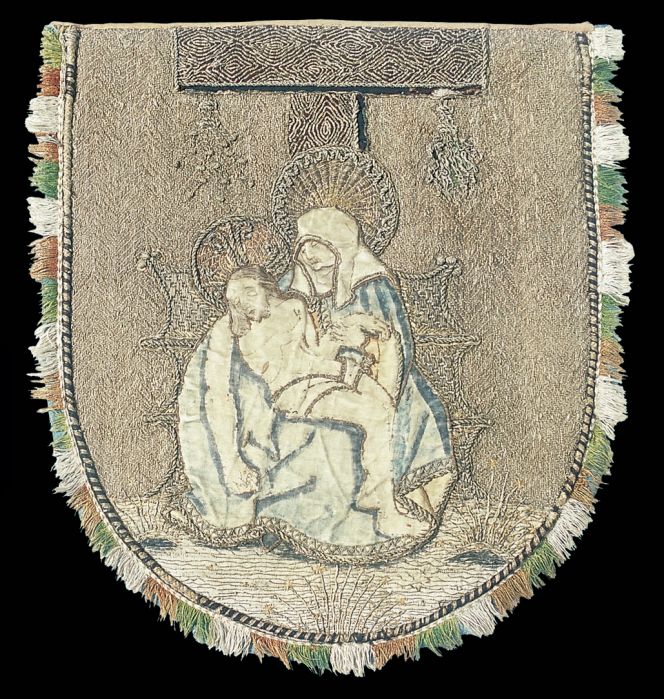 This well-preserved shield-shaped embroidery, originally decorated the back of a cope dating circa 1500. Depicted is the so-called “Pietà”, a frequently repeated motif in Christian art and particularly frequent in sculptures. This embroidery also demonstrates an advanced appliqué technique with partially blue painted white silk and metallic embroideries, on contours as well as on clothing. The background surface is fully covered with a complex laid work design of silk and metallic threads. The three-coloured silk fringe is skilfully stitched around the edge. Height 43 cm, width 36 cm. Photo: The IK Foundation, London.
This well-preserved shield-shaped embroidery, originally decorated the back of a cope dating circa 1500. Depicted is the so-called “Pietà”, a frequently repeated motif in Christian art and particularly frequent in sculptures. This embroidery also demonstrates an advanced appliqué technique with partially blue painted white silk and metallic embroideries, on contours as well as on clothing. The background surface is fully covered with a complex laid work design of silk and metallic threads. The three-coloured silk fringe is skilfully stitched around the edge. Height 43 cm, width 36 cm. Photo: The IK Foundation, London.Three fully preserved early 16th century chasubles also include appliqué embroideries, two of these were purchased and one was received as a gift to Malmö Museum in 1928-1930. The most complex was probably made in an Italian workshop [14.238], with the whole vestment covered in an applied leaf and floral pattern made of yellow, creme and green silks added with a red velvet quality. Furthermore, the edges of each and every piece of fabric are finished off with fine silk cords. The second example is possibly also Italian [19.118], made from an exquisite red velvet, with a centred wide border decorated with applied flowers of white silk fabrics and gold ribbons. The exclusive impression of the vestment was additionally strengthened with extensive laid work of gold/silk placed within medallions, added with a fringe of yellow and red silk. Lastly, a chasuble of white silk fabric is not far behind in complexity [16.331]. Decorations include knots, laid work, silk cords and an ornamental flower motif in appliqué sewn onto a border of yellow half silk, applied with velvet and silk cut-out pieces, and laid work of blue silk and linen thread. It is recorded that this vestment had its origin in Spain, while it was purchased by the museum in 1929 by the art dealer Abelardo Linares in Madrid.
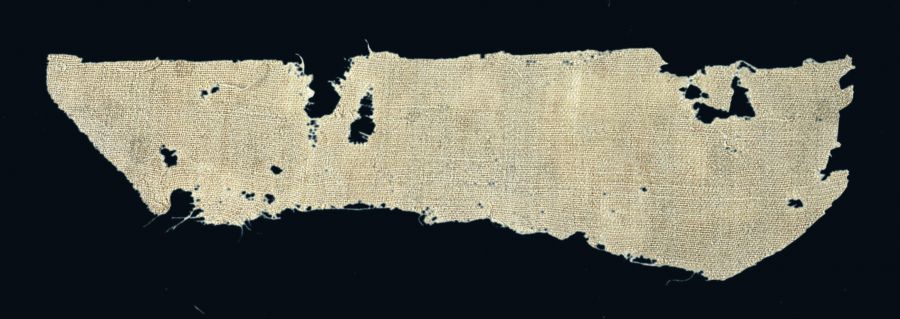 The St Petri Medieval collection includes this single plain woven linen fragment. A quality which was highly important for linen shirts and other garments, but also forming the foundation for the stitching of embroideries. On some of the preserved exquisite figure styled laid works of silk and gold one can also glimpse the plain woven linen, particularly evident in the first image of this essay. Photo: The IK Foundation, London.
The St Petri Medieval collection includes this single plain woven linen fragment. A quality which was highly important for linen shirts and other garments, but also forming the foundation for the stitching of embroideries. On some of the preserved exquisite figure styled laid works of silk and gold one can also glimpse the plain woven linen, particularly evident in the first image of this essay. Photo: The IK Foundation, London.Fringes of various kinds were typical embellishments on Medieval chasubles, copes and altar cloths – noted on several occasions in this series. Two separate fragments of this kind are preserved in the St Petri collection, either made as a tablet-woven ribbon with one loose “fringy side” or made over a type of roller. The techniques to produce both these types of fringes were fairly simple, especially if compared with the highly skilled embroideries and woven silks, but the silk materials of used fringes were just as exquisite as the rest of the vestments. This can be studied at a decoration of a Mass vestment [798] kept at the Malmö Museum, probably originating from 15th century Florence. At the same time, the museum bought this vestment via R. Ferruzzi (Florence) in 1967. Here, a magnificent green silk fringe is part of an ornamental border on a silk brocade illustrating “The Annunciation”.
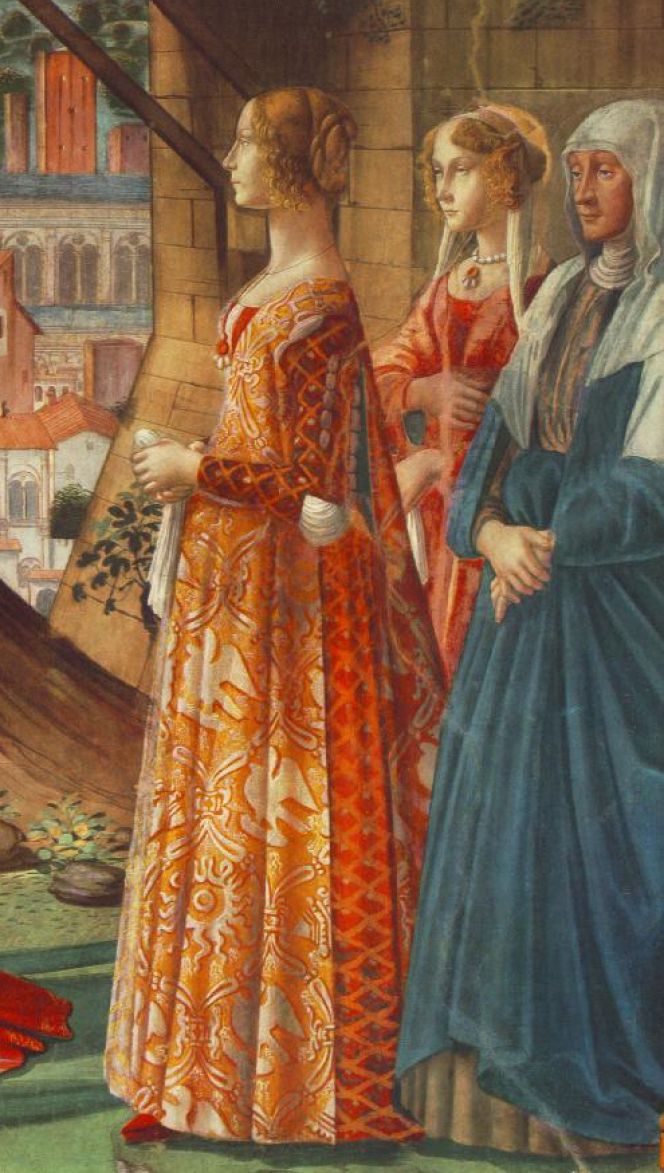 The detail of this fresco “The Visitation” in the Tornabuoni chapel, Santa Maria Novella church in Florence from circa 1488 – is one good example among a myriad of depictions from the 14th and 15th century revealing exquisite Italian silks or velvets in clothing and fashion. Fabrics of a similar sort were used for the ecclesiastical textiles in St Petri church, as well as for the wealthy citizens’ dress in Malmö. (Public Domain: Wikimedia).
The detail of this fresco “The Visitation” in the Tornabuoni chapel, Santa Maria Novella church in Florence from circa 1488 – is one good example among a myriad of depictions from the 14th and 15th century revealing exquisite Italian silks or velvets in clothing and fashion. Fabrics of a similar sort were used for the ecclesiastical textiles in St Petri church, as well as for the wealthy citizens’ dress in Malmö. (Public Domain: Wikimedia).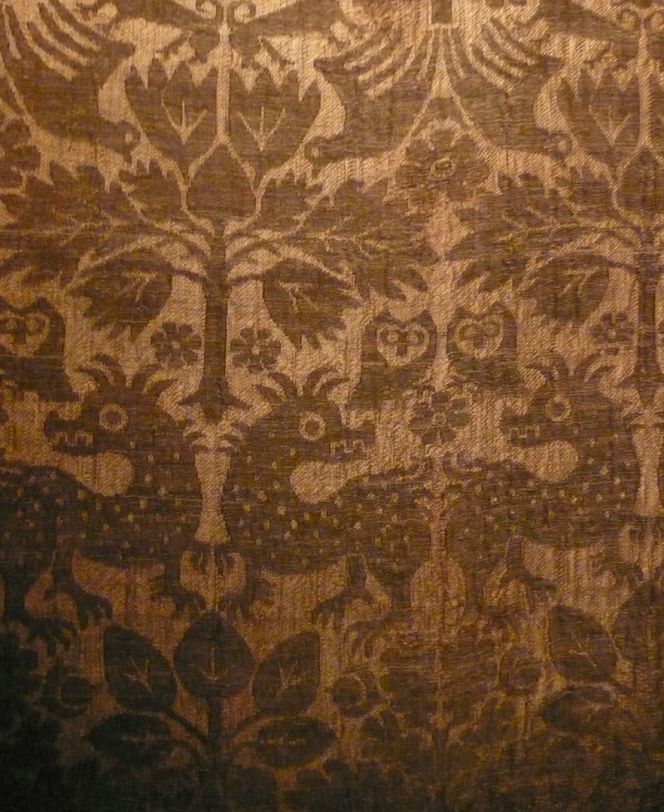 A close-up image of a fully preserved late Medieval chasuble once used in nearby Lund Cathedral is a representative vestment showing the complex silk fragments imported from the Continent to the Nordic area. This red half silk with membrane gold – consisting of a gold strip wound around a core of silk – has darkened in shade. However this vestment is not regarded as Italian by the Cathedral Museum, but instead of possible German origin. (Photo: Viveka Hansen, exhibition at the Cathedral Museum, Lund University Historical Museum).
A close-up image of a fully preserved late Medieval chasuble once used in nearby Lund Cathedral is a representative vestment showing the complex silk fragments imported from the Continent to the Nordic area. This red half silk with membrane gold – consisting of a gold strip wound around a core of silk – has darkened in shade. However this vestment is not regarded as Italian by the Cathedral Museum, but instead of possible German origin. (Photo: Viveka Hansen, exhibition at the Cathedral Museum, Lund University Historical Museum).The outstanding silk brocades, or cut and uncut velvets woven in specialised workshops, were often the foundation for these preserved late Medieval liturgical vestments and fragments ending up in Nordic churches. In the following essay of this series, the finely woven fragments – mainly regarded as Italian – in the St Petri collection will be looked at more closely.
Notice: A large number of primary and secondary sources were used for this essay. For a full Bibliography and a complete list of St Petri church textiles, see the Swedish article by Viveka Hansen.
Sources:
- Hansen, Viveka, ‘Kyrkliga textilier i Malmö – från medeltid till barock’, Elbogen pp. 61-135. 2000.
- Lund University Historical Museum, The Cathedral Museum (studies/comparisons of ecclesiastical Medieval textiles in exhibition 2015, originally in use at Lund Cathedral).
- Malmö Museums, Malmö, Sweden (four chasubles researched in 1999 & 2000, catalogue numbers within square brackets).
- St Petri Church, Medieval Church Collection, Malmö, Sweden (researched in 1999 & 2000. If not otherwise stated, all textile fragments are part of the St Petri collection).
Essays
The iTEXTILIS is a division of The IK Workshop Society – a global and unique forum for all those interested in Natural & Cultural History from a textile Perspective.
Open Access essays, licensed under Creative Commons and freely accessible, by Textile historian Viveka Hansen, aim to integrate her current research, printed monographs, and earlier projects dating back to the late 1980s. Some essays feature rare archive material originally published in other languages, now available in English for the first time, revealing aspects of history that were previously little known outside northern European countries. Her work also explores various topics, including the textile trade, material culture, cloth manufacturing, fashion, natural dyeing, and the intriguing world of early travelling naturalists – such as the "Linnaean network" – viewed through a global historical lens.
For regular updates and to fully utilise iTEXTILIS' features, we recommend subscribing to our newsletter, iMESSENGER.
been copied to your clipboard




– a truly European organisation since 1988
Legal issues | Forget me | and much more...
You are welcome to use the information and knowledge from
The IK Workshop Society, as long as you follow a few simple rules.
LEARN MORE & I AGREE







